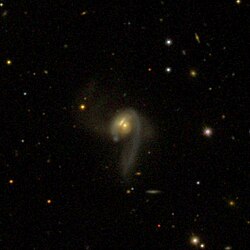| NGC 4320 | |
|---|---|
 SDSS image of NGC 4320. | |
| Observation data (J2000 epoch) | |
| Constellation | Virgo |
| Right ascension | 12h 22m 57.7s [1] |
| Declination | 10° 32′ 54″ [1] |
| Redshift | 0.026675 [1] |
| Heliocentric radial velocity | 7997 km/s [1] |
| Distance | 370 Mly (114 Mpc) [1] |
| Group or cluster | NGC 4325 Group |
| Apparent magnitude (V) | 15.3 [1] |
| Characteristics | |
| Type | S? pec [2] |
| Size | ~120,000 ly (38 kpc) (estimated) [1] |
| Apparent size (V) | 0.70 x 0.53 [1] |
| Other designations | |
| UGC 07452, VCC 0599, PGC 040160, MCG +02-32-018 [1] | |
NGC 4320, is a peculiar galaxy [2] located about 370 million light-years away [3] in the constellation Virgo. It was discovered by astronomer Heinrich d'Arrest on April 15, 1865 [2] and is a member of the NGC 4325 Group. [4] [5] [6]
Contents
NGC 4320 appears to be the end result [2] of an interaction [7] and merger of two spiral galaxies. [2]